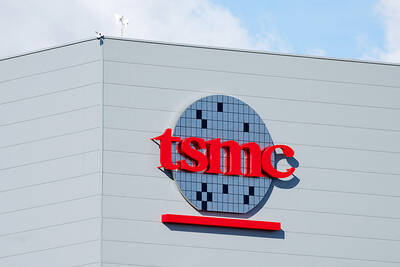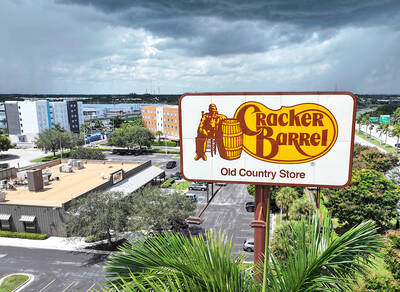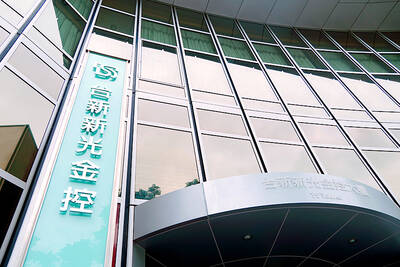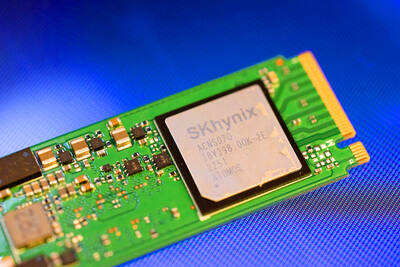Gintech Energy Corp (昱晶) yesterday reported its first quarterly loss in five quarters, as prices plunged amid sluggish demand from China.
The solar cell manufacturer swung into a quarterly loss of NT$2.56 billion (US$80.1 million) during the quarter ending Sept. 30, compared with a quarterly net profit of NT$93 million in the second quarter and NT$139 million in the third quarter last year.
That was the deepest quarterly loss Gintech has ever booked in its history.
Gross margin tumbled to minus-104.9 percent last quarter, from 6.5 percent a quarter ago and 9.7 percent a year earlier, the company’s financial statement showed.
Gintech blamed a downward spiral in solar cell prices and lower factory utilization fot the poor gross margin.
In addition, a raw material prepayment write-off of NT$1.2 billion cut into its margins, Gintech said.
Excluding the one-off write-off, gross margin would have fallen to minus-49.6 percent last quarter, it said.
However, the company expects some improvement, saying: “We believe the industry has gone through a short-term adjustment resulting from a temporary slowdown in the Chinese market.”
China is the world’s largest solar market with annual installation forecast to reach 21.56 gigawatts this year, accounting for 34 percent of the global solar market, TrendForce Corp (集邦科技) said.
Average selling prices have rebounded more than 20 percent recently, after touching bottom last quarter, the company said.
Gintech attributed the price recovery to the introduction of China’s new subsidy programs for solar installation projects as well as output cuts last quarter.
“We expect our profitability to improve as we see a more stable pricing environment in the coming months. We are also boosting utilization to meet a pickup in demand,” it said.
Gintech’s revenue rose 14.7 percent to NT$822 million last month from NT$716 million in September. The figure was the highest since July.
Gintech shares fell 0.5 percent to NT$19.80 yesterday, while local rivals Motech Industries Inc (茂迪) and Neo Solar Power Corp (新日光能源) climbed 0.38 percent and 3.08 percent to NT$26.35 and NT$15.05 respectively.
Motech and Neo Solar reported quarterly losses of NT$999 million and NT$1.87 billion respectively.

Taiwan Semiconductor Manufacturing Co (TSMC, 台積電) secured a record 70.2 percent share of the global foundry business in the second quarter, up from 67.6 percent the previous quarter, and continued widening its lead over second-placed Samsung Electronics Co, TrendForce Corp (集邦科技) said on Monday. TSMC posted US$30.24 billion in sales in the April-to-June period, up 18.5 percent from the previous quarter, driven by major smartphone customers entering their ramp-up cycle and robust demand for artificial intelligence chips, laptops and PCs, which boosted wafer shipments and average selling prices, TrendForce said in a report. Samsung’s sales also grew in the second quarter, up

On Tuesday, US President Donald Trump weighed in on a pressing national issue: The rebranding of a restaurant chain. Last week, Cracker Barrel, a Tennessee company whose nationwide locations lean heavily on a cozy, old-timey aesthetic — “rocking chairs on the porch, a warm fire in the hearth, peg games on the table” — announced it was updating its logo. Uncle Herschel, the man who once appeared next to the letters with a barrel, was gone. It sparked ire on the right, with Donald Trump Jr leading a charge against the rebranding: “WTF is wrong with Cracker Barrel?!” Later, Trump Sr weighed

HEADWINDS: Upfront investment is unavoidable in the merger, but cost savings would materialize over time, TS Financial Holding Co president Welch Lin said TS Financial Holding Co (台新新光金控) said it would take about two years before the benefits of its merger with Shin Kong Financial Holding Co (新光金控) become evident, as the group prioritizes the consolidation of its major subsidiaries. “The group’s priority is to complete the consolidation of different subsidiaries,” Welch Lin (林維俊), president of the nation’s fourth-largest financial conglomerate by assets, told reporters during its first earnings briefing since the merger took effect on July 24. The asset management units are scheduled to merge in November, followed by life insurance in January next year and securities operations in April, Lin said. Banking integration,

LOOPHOLES: The move is to end a break that was aiding foreign producers without any similar benefit for US manufacturers, the US Department of Commerce said US President Donald Trump’s administration would make it harder for Samsung Electronics Co and SK Hynix Inc to ship critical equipment to their chipmaking operations in China, dealing a potential blow to the companies’ production in the world’s largest semiconductor market. The US Department of Commerce in a notice published on Friday said that it was revoking waivers for Samsung and SK Hynix to use US technologies in their Chinese operations. The companies had been operating in China under regulations that allow them to import chipmaking equipment without applying for a new license each time. The move would revise what is known